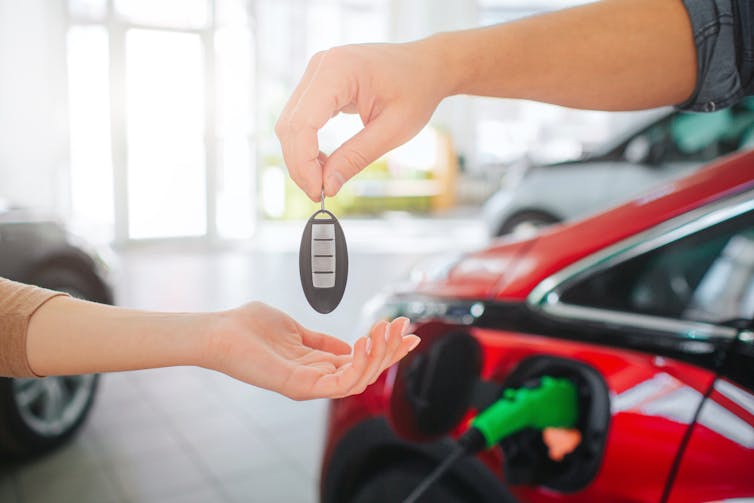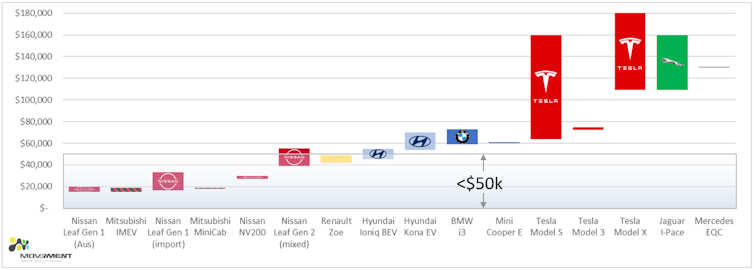Source: The Conversation (Au and NZ) – By Alina Dini, Industry Fellow at the Institute for Future Environments, Queensland University of Technology
Many Australians say they would consider buying an electric car. But unfortunately, new electric vehicles don’t come cheap.
Even at the more affordable end of the market, a new Nissan Leaf or Hyundai Ioniq cost around A$50,000. The popular Tesla Model 3 would set you back A$66,000.
But there’s another option: buy second-hand. A used electric vehicle can be yours for under A$20,000. However supply is limited and, like with any major purchase, there are pitfalls to watch for.
I’m an energy consumer advocate, researcher and electric vehicle owner, and have helped friends and family buy their electric cars. So let’s take a look at where to find second-hand electric cars in Australia, and what to think about before handing over your cash.

Where to find one?
The supply of used electric vehicles in Australia is limited. Numbers are obviously tied to new vehicles sold, and the rate at which they end up in the used car market.In 2019, 6,718 fully electric and plug-in hybrid electric cars were sold in Australia – triple the previous year, but still a relatively small number. And the young age of Australia’s electric vehicle fleet means there hasn’t been much turnover into the used market.
Used electric vehicles are generally found in the same places you’d find other second-hand cars. These include car dealerships and private sellers.
At the time of writing, about 120 used electric vehicles were for advertised on Carsales – the cheapest was a 2013 Nissan Leaf in Victoria for A$11,500. Sites such as Autotrader and Gumtree also sell them – however electric vehicles are a tiny proportion of overall listings.
Read more: Owners of electric vehicles to be paid to plug into the grid to help avoid blackouts
Tesla, by far the most popular electric vehicle producer in Australia, offers second-hand cars on its website, but currently none are available.
Former government electric vehicles can appear for sale on auction sites such as Pickles or Manheim.
In recent years, specialist electric vehicle importers have emerged in Australia. These include Good Car Company, which has brought in about 50 second-hand vehicles to date, mostly from Japan. They sell for as low as A$19,000.
The following graph gives a breakdown of second-hand electric vehicles available in Australia in August this year. Prices range from A$19,000 for a first-generation Nissan Leaf to A$180,000 for a Tesla Model X.

Buyers’ guide
Naturally, anyone buying a second-hand electric car wants to know they’re getting a good deal, and the vehicle is reliable.
You should check the usual things such as mileage, body condition, maintenance records, safety ratings and tyre condition. You should also keep in mind other things specific to electric vehicles:
1. Battery health
Over time, batteries in electric vehicles lose “range” – the distance they can drive on a single charge. The rate of loss can depend how and where the vehicle is driven. Batteries typically respond poorly to extremes – heat, cold, or other harsh driving or charging behaviours. So the condition of your battery should be top of mind when buying and maintaining an electric vehicle.
Many second-hand electric cars come with a battery diagnostic report from the seller. If they don’t, you can request this test or check the car’s onboard computer. Ideally, the battery should be at 80% or more than its original rated capacity.
2. Warranty and servicing
Warranties are a big consideration when buying any car. For electric vehicles, the battery and vehicle have separate warranties, and most offer greater coverage for the battery than the car. An eight-year warranty on a new car battery, which passes to successive owners, is standard. Good Car Company offers a two-year warranty on the battery of its imports.
The good news is electric vehicles have few moving parts, and require less servicing than conventional cars. Specialist servicing companies such as EVolution support the budding second-hand market. Still, it’s a good idea to check the terms of a car’s warranty, and how it can be serviced locally.

3. Charging needs
Electric vehicle charging is done at home or at public or private charging points.
Most used electric vehicles in Australia will be compatible with highway chargers, but early models and imports may require an adapter. Be sure to check your car’s plug type, and when charging outside of your home, use an app like Plugshare or Nextcharge to ensure the charging station works for your car.
Home charging can be done via a normal domestic electricity supply. But installing a dedicated electric vehicle charger at home is the safest and most efficient option.
An electric future
Unfortunately, Australia lacks the strong policies required to stimulate new electric vehicle sales, which would flow on to the second-hand market.
For example, unlike most of our international peers, Australia has not imposed fuel efficiency standards to discourage the use of polluting cars. It has also failed to follow the lead of nations such as the UK and France, which have set a target date for banning sales of new petrol and diesel cars.
If all levels of government in Australia transitioned their vehicles to an electric fleet, this would provide a regular influx into the used car market as the fleets are updated.
In New Zealand, electric vehicle registrations have steadily increased since 2016 when targeted policy was introduced. As of this month, 63% of electric vehicles sold in New Zealand were second-hand.
Electric vehicles are affordable to run, easy to maintain and good for the planet. Now we need to ensure as many Australian motorists as possible can go electric – and the second-hand market is key.
Read more: We thought Australian cars were using less fuel. New research shows we were wrong
– ref. Want an electric car, but think you can’t afford one? Here’s how to buy second-hand – https://theconversation.com/want-an-electric-car-but-think-you-cant-afford-one-heres-how-to-buy-second-hand-147173








